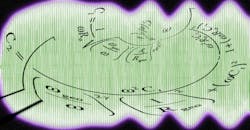Sounders flown in space and in the air have been used for spectroscopic characterization of the Earth’s atmosphere, performing molecular spectroscopy at millimeter- and submillimeter-wave frequencies. Filtering is an essential part of these systems, to prevent interference from unwanted sideband and interference signals in radiometers.
To learn more about achieving the best waveguide filtering performance at WR-3 frequencies from 220 to 325 GHz, researchers based at the University of Birmingham and other leading universities in the UK investigated two different fabrication methods for the filters: one of the filters was formed in metal by means of computer numerically controlled (CNC) milling and the other by means of metallized SU-8 photoresist technology. The filters were designed as potential replacements for the frequency-selective surfaces (FSSs) currently used for filtering in heterodyne radiometers employed for atmospheric characterization.
By using the two different fabrication approaches, the researchers could compare current versus potential future ways of building very high-frequency waveguide filters. CNC methods are well established for creating waveguide components, although they can be limited in machining resolution at extremely high millimeter-wave frequencies, and CNC milling methods can be expensive when forming precision waveguide components at very high millimeter-wave frequencies.
Both filter designs consist of three coupled resonators, and the SU-8 photoresist fabrication approach was used to form three silver-coated SU-8 layers. SU-8 is a photolithographically patterned, epoxy-based resin that can be cured with typical thicknesses ranging from 0.5 μm to 1 mm. This fabrication approach can form the waveguide features needed for millimeter-wave components with the same or greater precision and resolution as CNC machining, but at a fraction of the fabrication cost.
The researchers designed and constructed WR-3 bandpass filters with the two different fabrication approaches. They used CAE software for simulation modeling and commercial high-frequency vector-network analyzers (VNAs) for S-parameter measurements, using an analyzer from Keysight Technologies coupled with frequency-extension modules from Virginia Diodes to achieve the frequency coverage needed for characterizing the filters.
In spite of the two different fabrication approaches, the two bandpass filters both exhibit excellent insertion-loss and return-loss characteristics within the WR-3 frequency range, with close agreement between the measured results and the computer simulations. Given the cost of CNC machining at these frequencies and waveguide dimensions, the use of SU-8 photolithography certainly shows great promise for the future fabrication of high-frequency waveguide components.
See “WR-3 Waveguide Bandpass Filters Fabricated Using High Precision CNC Machining and SU-8 Photoresist Technology,” IEEE Transactions on Terahertz Science and Technology, Vol. 8, No. 1, January 2018, p. 100.
About the Author
Jack Browne
Technical Contributor
Jack Browne, Technical Contributor, has worked in technical publishing for over 30 years. He managed the content and production of three technical journals while at the American Institute of Physics, including Medical Physics and the Journal of Vacuum Science & Technology. He has been a Publisher and Editor for Penton Media, started the firm’s Wireless Symposium & Exhibition trade show in 1993, and currently serves as Technical Contributor for that company's Microwaves & RF magazine. Browne, who holds a BS in Mathematics from City College of New York and BA degrees in English and Philosophy from Fordham University, is a member of the IEEE.

